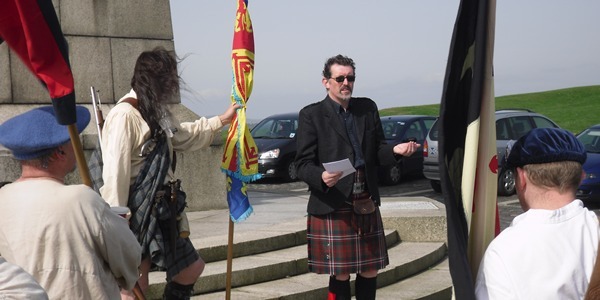One of the most significant events in Scotland’s history was commemorated on Dundee Law.
Members of several Jacobite re-enactment societies in period costume, and local author Andrew Murray Scott, marched from Dudhope Castle to the top of the Law.
They recreated the raising of the royal standard of King James VII and II on 13th April, 1689.
Mr Scott said that event triggered the first Jacobite rebellion, putting Dundee at the centre of UK politics when the rival claims of King James and the invader William of Orange were in dispute in Scotland with England having already accepted the new monarch.
He said Dundee was the starting place for the Jacobite movement and John Graham of Claverhouse, Viscount Dundee, or Bonnie Dundee as he was known, was the first Jacobite leader.
Mr Scott, who wrote a biography of Bonnie Dundee and also collected and edited Claverhouse’s letters for the Scottish History Society, spoke on the Law of the political and historical context of 1689 and the background to the event.
He said, “A number of suggestions have been raised by historians as to why Bonnie Dundee ‘stuck his neck out’ on behalf of King James when most of the leading nobles were waiting to see which way the wind was blowing.
“It has been said that he was ‘an unthinking servant of the Stuarts’, or a reckless gambler intent on bravado, or that he had calculated greater rewards would come if he could restore James.
“When you consider all of these potential motives you have to conclude that it was a difficult decision to make.
“But Claverhouse took it at some risk to his family and himself and stuck with it, doing his utmost over the final three months of his life to achieve his aims, before his untimely and almost accidental death at Killiecrankie.
“His was a fight for a principle in which he believed. At that time nearly everyone in Scotland was potentially a supporter of James. The Stuarts had reigned in Scotland since 1371, and some said for hundreds of years before that.
“Replacing them by a foreign line was not something done lightly. The Williamites were a small minority, and in April 1689 could have been relatively easily overthrown in Scotland.
“They did not have popular support although they did have an English-Dutch army backed with elements of the Scots army which Claverhouse had previously led.
“But Dundee’s prodigious efforts were undermined by the deviousness of leading nobles on both sides and particularly by James’ leading adviser, the Earl of Melfort who, instead of assisting Dundee, betrayed him, denied him resources and successfully kept that fact from the king.
“Bonnie Dundee is a tragic and glamorous figure and one of the best known and most significant historical figures associated with the city of Dundee, and it is appropriate that we commemorate this significant event every year of which all Dundonians should be proud.”
